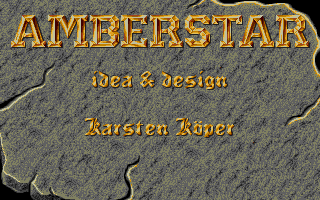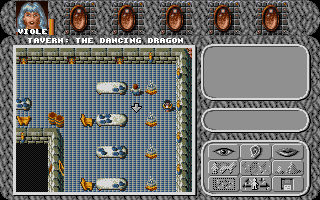From The CRPG Addict
Amberstar
Germany
Thalion Software (developer and publisher)
Released 1992 for Amiga, Atari ST, and DOS
Date Started: 20 June 2020
Amberstar is the first game I can remember that starts better if you haven’t read the manual. First of all, the manual is 168 pages–and it explains so little about what you experience in the game’s opening hours that it might as well be written for a different game. Second, it sets up a less interesting quest than the game itself. The manual’s story is all about the standard evil wizard trying to take over the world. The Amulet of Yendor that can stop him has been broken into 13 pieces, each one hidden somewhere across the land. Yawn. It made me realize that we have the terms Amulet of Yendor or MacGuffin for the Artifact That The Hero Must Find, but we need a separate term for when the MacGuffin is broken into multiple pieces.
Anyway, the actual game begins with no mention of any of this. Instead, the starting character is in a cemetery, mourning over (in my case) her parent’s graves, recalling how they were recently murdered by a band of orcs attacking their carriage. Left with nothing to do, the character heads into the nearby city and starts looking for adventure.
Amberstar is the first game I can remember that starts better if you haven’t read the manual. First of all, the manual is 168 pages–and it explains so little about what you experience in the game’s opening hours that it might as well be written for a different game. Second, it sets up a less interesting quest than the game itself. The manual’s story is all about the standard evil wizard trying to take over the world. The Amulet of Yendor that can stop him has been broken into 13 pieces, each one hidden somewhere across the land. Yawn. It made me realize that we have the terms Amulet of Yendor or MacGuffin for the Artifact That The Hero Must Find, but we need a separate term for when the MacGuffin is broken into multiple pieces.
Anyway, the actual game begins with no mention of any of this. Instead, the starting character is in a cemetery, mourning over (in my case) her parent’s graves, recalling how they were recently murdered by a band of orcs attacking their carriage. Left with nothing to do, the character heads into the nearby city and starts looking for adventure.
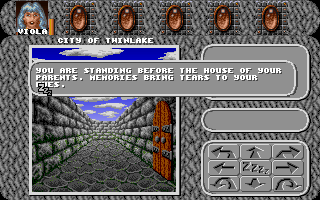 |
| The character is reminded of the backstory when she gets to her house. |
If you read the manual, there’s quite a bit of confusion at the beginning of the game when it comes to character creation. The manual tells you that you can have up to six characters, and it sets up a pretty standard Dungeons and Dragons-derived system for their creation. Races are human, elf, dwarf, gnome, halfling, half-elf, and “half-ork.” Attributes are strength, intelligence, dexterity, speed, constitution, charisma, luck, magic resistance, and age. Races have the usual advantages with attributes (e.g., dwarves and half-orcs get the highest strength, halflings the highest dexterity, humans are average across the board); the highest value that anyone gets is 100.
Classes are warrior, “paladine,” ranger, thief, monk, white wizard, grey wizard, and black wizard. The wizard classes are interesting. Like Thalion’s previous Dragonflight (and, oddly, like Final Fantasy), magic is split into white (mostly healing) and black (mostly offensive) varieties. I figured “grey” wizards would be able to cast both, but it turns out they have their own set of spells, focused mostly on adventuring (“Light,” “Magic Compass,” “Identification”) and buffing. Paladines get some white magic abilities, monks get some grey magic, and rangers get both white and grey. There are typical racial restrictions on classes. That is, humans get to be anything. Mages otherwise have to be elves, half-elves, or gnomes. Dwarves can only be warriors or monks, half-orks only warriors or thieves. That kind of thing.
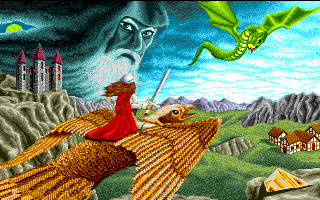 |
| This interesting screen precedes the more boring title screen. |
There are ten derived skills: attack, parry, swim, listen, find traps, disarm traps, pick locks, search, read magic, and use magic. Thieves so far outclass anyone else for swim, listen, find traps, disarm traps, pick locks, and search that it seems foolish to travel without one, although both monks and rangers have some skill in those areas.
Anyway, most of this setup is ignored during actual character creation. You only get to make one character, and I guess it’s a human since the attributes are all rolled on a scale of 60, but the race isn’t specified anywhere on the character sheet. Neither is the class. She gets no initial magic statistic at all, nor any thief-specific or mage-specific skills. Your only choices are sex, name, and the ability to hit “reroll” as many times as you want for the initial attributes. I was a bit disappointed that I couldn’t create a six-character party, as I had a whole “color wheel” thing worked out, with characters named Violet, Indigo, Magenta, Vermillion, and Chartreuse. Then it turns out that the game only displays the first five letters, so I changed Violet to Viola.
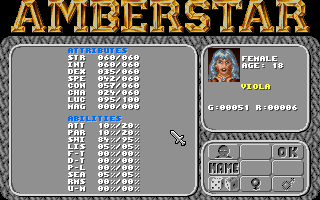 |
| Too bad no class favors both strength and intelligence. |
The character starts in the city cemetery next to her parents’ graves. She has clothes, shoes, a knife, and a small, random number of gold pieces. The cemetery is presented in top-down, iconographic form, but most of the rest of the city uses a first-person interface. Either way, movement is turn-based and tiled.
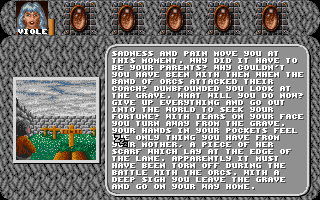 |
| A little bit of backstory for the character. |
The interface and I are going to struggle a bit before we come to some accord. I suspect the game really wants you to play with the mouse. To move, you can either click on the movement pad or on the map window itself, where the cursor changes to an arrow indicating direction of movement relative to the party’s current position. If you right-click on the movement pad, other options appear: look, listen, talk, mount/dismount transport, cast spell, camp, automap, battle formation, and disk options. Clicking any of these might change the pad to show even more options. In any event, the numberpad on the keyboard always corresponds, positionally, to the buttons on the screen pad. So far, so good, but if you want to use the keyboard in conjunction with the mouse and you’re right-handed, you have to awkwardly position your left hand on the numberpad while your right hand controls movement with the mouse. You don’t want to control everything with the keyboard because constant switching between the action options and the movement options is annoying. I really need to invest in an external numberpad for times like this, but it would have been nice if the developers had mapped the action items to sensible keys, like L)ook and T)alk, or at least used the QWEASDZXC cluster as analogues for the action pad and left the numberpad for movement alone.
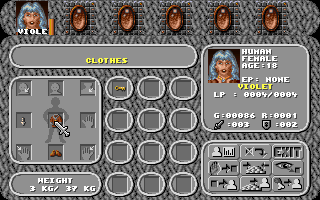 |
| The options on the “action pad” change depending on what screen you’re on. |
Also annoying is that the “Look” and “Talk” commands bring up a cursor, which you then have to click on the object that you want to look at or talk to. Since you can only ever look at or talk to things immediately adjacent to the character, it would have been more intuitive to have the player specify a direction after using those options rather than clicking on something, particularly since it’s easy to mis-click on the wrong thing. If you mis-click too close to the character, it opens the inventory screen, which is particularly annoying.
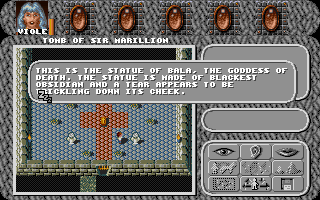 |
| Viewing statues in Marillion’s tomb. |
The cemetery has some statues and gravestones that you can look at, plus a sub-area inside the Tomb of Sir Marillion. If you wander into the tomb, you find statues dedicated to Gala, the goddess of life, and Bala, the goddess of death. A memorial to Marillion says that “his life was dedicated to light and his soul will escape from the shadows.” Marillion ties into the game’s backstory, which has to do with the return, after a thousand years, of an ancient wizard named Tarbos. I’ll summarize his full story–which takes up 79 pages of the manual–later on, but for now suffice to say that he was the mortal spawn of the King of Hell and he tried to conquer the world (called Lyramion) a millennium ago. A cabal of wizards gathered in the castle Godsbane and cast a spell that banished him to one of Lyramion’s moons. Knowing that the only way for him to return is if someone cast a counterspell within Godsbane, the wizards magically sealed the castle with an artifact called the Amberstar, then divided the star into 13 pieces. A group of knights kept watch over the castle for the next thousand years. Recently, the castle was invaded by a dark wizard named Marmion, who killed the knights and their commander, Sir Marillion. Marmion used magic from the King of Hell to get into the castle without the Amberstar, so now someone needs to reunite the 13 pieces of the Amberstar to get back into the castle and stop him from performing the ritual to recall Tarbos.
All of this is far in the future for our orphan, though, who leaves the top-down cemetery to find herself in a first-person city called Twinlake. Size. A competent automap keeps track of where you’ve been but not the names of various locations and services, so I made my own. The map occupies 32 x 30 coordinates, but using worm tunnels and still leaving a lot of space unused.
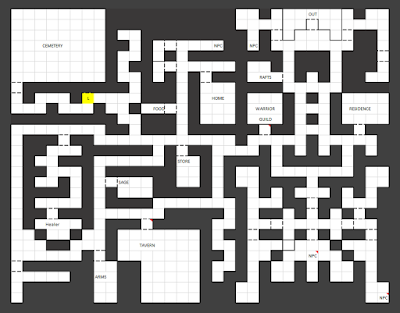 |
| My map of the opening city. |
Twinlake has the usual slate of RPG services: a couple of shops, a healer, a food store, a stable, guilds for wizards and thieves, a sage to identify equipment, a tavern, and a store selling rafts. The PC’s house is also here, and both it and the tavern switch to a top-down map for exploration. The textured corridors of the first-person section are pretty dull and featureless, so the game’s approach seems to be to switch to an iconographic interface whenever it wants to do anything interesting. There are no combats in the city itself.
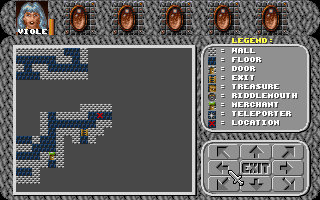 |
| The automap works okay except that it shows nothing where the iconographic sections are. |
There are a few NPCs wandering the corridors. Some of them offer only a quick scripted dialogue, but others allow you to ask about keywords, including an option to type in your own keyword if it’s not on the list. While I like such keyword systems, this one seems to retain in the list every keyword that you’ve ever gotten from any NPC. This is a bit annoying because I feel like I have to click on each keyword just in case.
 |
| Speaking with the ghost of a dead knight, I still have options to ask about the COOK in the town’s tavern. |
A wizard warns me that magical items have limited charges. A ranger suggests I take unidentified items to sages and pay them to identify them. A guard warns me to avoid bubbles in swamps because they release deadly gases, and another guard warns me of orc activity north of Twinlake. A young girl named Sunny wants my help finding her lost cat, Felix, for which she promises to tell me a great secret. The cat was lost near the cemetery. In a castle-looking configuration in the southeast of town, I run into Lord Karwain, apparently the ruler of the town, who is looking for someone to descend into the sewers, where something is stirring and soldiers have disappeared.
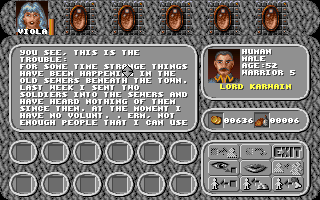 |
| The first major quest of the game. |
My parents must have been pretty wealthy to have such a big house in the middle of the city. I entered using the key that came with the character; keys disappear when they fulfill their purpose, which would have been a nice addition to The Black Gate. There was one locked door in the house, but also a key to open it. Among the various rooms, I found a few hundred gold pieces, a set of chainmail, a short sword, a pair of boots, and a few other items. Right now, my undeclared character can’t wear the armor or wield the sword. The family dog is still in the house, hanging around the kitchen, and I feel bad that I can’t take him with me. Is he just going to starve to death?
 |
| My old bedroom. |
It takes me a few minutes to get used to the game’s inventory system. If you’re going to make me use the mouse, then let me drag items from chests directly to my character portrait (like The Black Gate) rather than forcing me to click separate buttons for “take item out of the chest” or “put item in the chest” first. But there are things I like about it, particularly the ability to click with the eye icon on any object and get a full rundown of its statistics and what classes are able to wield it. A screen like this should be required by law in every CRPG. Not really, of course, because that would be a huge overreach of governmental powers, and impossible to enforce in an international industry, but you get what I mean. On the negative side, ammunition (arrows, sling stones) seem to show up as individual, unstackable objects, which I think might be a dealbreaker for using those weapons.
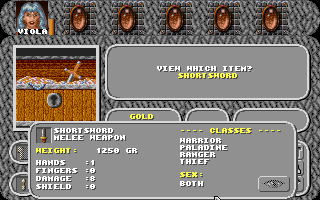 |
| The short sword’s stats show me exactly how much damage it can do and who can equip it. |
The tavern was a large building also in iconographic form. Initiating conversation with NPCs is a bit different in this interface, but the result–including the selection of keywords–is the same. A beggar tells me that the ghost of Sir Marillion appears at his grave at midnight. A family friend invites me to make use of his father’s old house, north of town, where many of his “inventions” still sit unused. A dwarf worries that all the orc and troll attacks lately heralds Tarbos’s return. (The game is inconsistent in whether it’s spelled “orc” or “ork,” unless it intends two different creatures. I guess I’ll use the standard spelling from now on.) One cook lost his ring down the drain (perhaps to be found in the sewers); the other wants me to retrieve a decent bottle of wine from the cellar, where something “large and slimy” has lately taken up residence.
 |
| Trying to talk to something in the tavern’s kitchen. Maybe it was a cat. |
Most important, I soon find my first companion: A shaggy-haired, mustachioed man incongruously named “Silk.” Like me, he’s an undeclared class. He’s looking for the thieves’ guild and wants to join. It just so happens I have already wandered through the illusory door to the thieves’ guild accidentally, so I know where it is, but when I visit both it and the warriors’ guild, the options to join are greyed out. I assume this is how you declare your class, and I further assume that we’ll need some combination of experience or money before they’ll let us in. I don’t know where the other guilds are, so I wonder how long you have to play the game if you want the main character to be a “paladine” (the game is consistent about this, so I’ll stop using quotes) or ranger or mage.
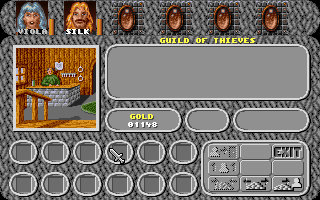 |
| We find the guild but not anything to do there. |
The rumor about Marillion’s ghost intrigues me, so I returned to the cemetery (also to search for Felix) and wait in Marillion’s tomb until his ghost does, in fact, appear. Unfortunately, it just rants about the attack on Godsbane and doesn’t have anything useful to offer. There’s a locked door in the tomb, so I expect some later quest allows me to interact with him more productively and unlock this door. I don’t see any sign of Felix.
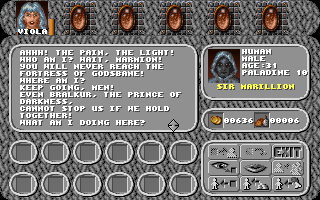 |
| Marmillion is clearly reliving his death. |
At this point, I already have four explicit quests:
- Find Felix for Sunny
- Figure out what’s going on in the sewers for Lord Karwain
- Find the cook’s ring in the sewers
- Get the wine bottle from the tavern cellars
I decide to try the tavern cellars first. I struggle with the interface for a while before I figure out how to light a torch. I don’t see why clicking on it isn’t enough; you have to click the “use” button first.
Dungeon exploration is pretty straightforward. You get atmospheric messages as you move along. If you want to search something more thoroughly, you stop and hit the “eye” icon. The automap works as long as you have a light source. Unfortunately, torches don’t last long, and I only started with two, so after the first dies, I light the second and make a rush back to the stairs. Clearly, I’ll have to go to the store for more.
 |
| The game shows in its iconographic sections, tells in its first-person sections. |
Miscellaneous notes:
- There is only one save slot. Saving the game is bizarre when you have party members, because for some reason you also click on the “save” button to get rid of them. The game presents this to you with the question, “Would you like to let members of the group go?” and then presents two options: “Exit” and “OK.” “OK” makes it sound like yes, you want to let members of the group go, but if you hit “Exit,” you don’t save. In fact, what “OK” does is get rid of members that you’ve selected while simultaneously saving, so to keep the party as-is, you just hit “OK” without selecting anyone. It’s still ridiculously confusing like a lot of the interface.
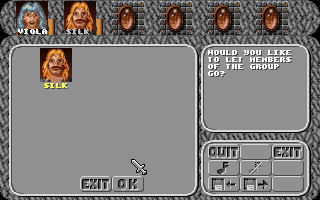 |
| How would you interpret this screen? |
- There’s a day/night cycle, and NPCs in the iconographic parts of the game keep to a schedule, retiring to bed at night and moving about during the day. In the first-person side, NPCs are constantly present, but stores open and close based on the cycle. The character finds a magic painting in his house that changes based on whether it’s day or night, allowing her to determine the rough time even in a dungeon, though I can’t help but think a watch would have been more convenient.
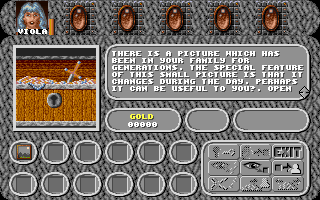 |
| Acquiring the useful-but-cumbersome painting. |
- There’s a food system, but you don’t have to eat to stave off hunger. Rather, you simply have to have food in your inventory if you want to regenerate hit points and spell points when you rest. Both only regenerate 10% even if you have food, so I assume there’s going to be better mechanisms for this. There are pools in Sir Marillion’s tomb that regenerate both, for instance.
- If you decide you don’t like your main character and change him or her during the game’s opening stages, reloading your saved game will just replace the character but maintain your auto-map, dialogue keywords, and save position. I haven’t tested how it affects gold or inventory, as I hadn’t spent or acquired anything when I changed my character. I assume there’s a point at which this is no longer possible.
- I have a hard time spotting some doors in the iconographic sections. I have an equally hard time telling what some of the icons are supposed to be.
- The game apparently has no sound effects, just music. Town exploration is accompanied by a theme-and-variations composition. The theme is eight bars and goes through eight variations with different instrumentation and ornamentation. Each variation takes 10 seconds, and the A section is repeated, so you have 90 seconds of music before the piece cycles back to the beginning. I say all of this because the game gets praised for its music, and I wanted you to know I took time to listen and analyze before turning it off permanently.
It always feels incomplete when I don’t have the opportunity to even taste combat for the first entry, but this was already getting pretty long.
I end where I started: This is a promising beginning to a game that would be more promising if I didn’t already know it was going to devolve into a quest to collect 13 pieces of something to save the world. My idea of a perfect RPG is one in which my highborn ingénue, now forced to fend for herself in the real world, slowly develops the skills she needs to survive, assembles a team around her, and solves local problems until she’s strong enough to take on the orc band that killed her parents. Take her from Level 1 to Level 8 during this process and leave plenty of room for continued growth in the sequel.
 |
| This is the type of quest I enjoy. |
The only thing I can hope now is that the game doesn’t make the collection of the 13 pieces completely uniform and bloodless. Like each one is at the bottom of a 10-level dungeon. That would suck. A couple ought to be at the bottom of 10-level dungeons. A couple ought to be acquired by solving some kind of puzzle. A couple ought to be for sale. Mix it up. Keep the player guessing. Let him hope that the next one might be easy. Ultima VI did it well with the map quest, for instance. At first, I had some hope that the entire trilogy would be about finding the 13 pieces, and Amberstar was just the beginning, but a premature trip to Wikipedia killed that theory.
At least the game understands the concept of “side quests.” As I return to the rich world of Britannia, I’m reminded that ORIGIN never really got that concept right, not even in The Black Gate, which admittedly has more than the previous titles in the series.
Time so far: 3 hours
Original URL: http://crpgaddict.blogspot.com/2020/06/game-371-amberstar-1992.html

